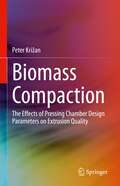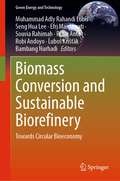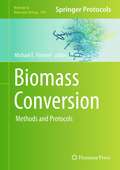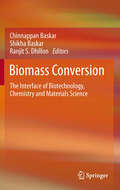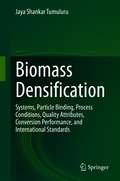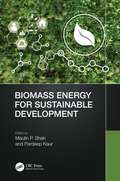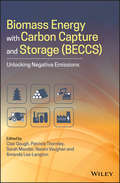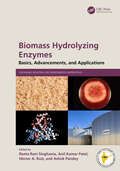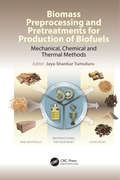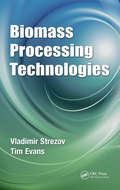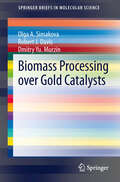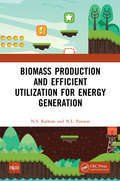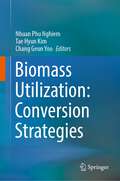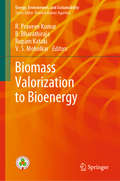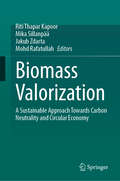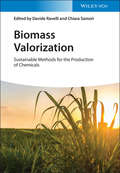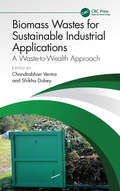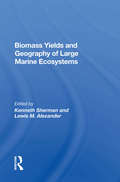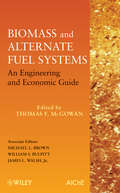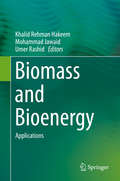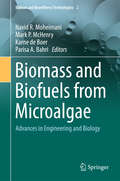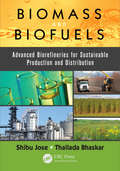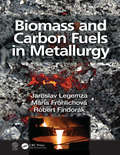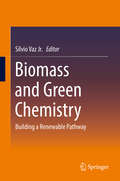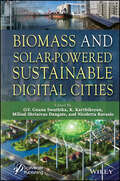- Table View
- List View
Biomass Compaction: The Effects of Pressing Chamber Design Parameters on Extrusion Quality
by Peter KrižanThis book discusses the scientific process of biomass compaction, focusing on pressing chamber parameters and their influence on the quality of extrusions from biomass. It yields new knowledge in the field of wood biomass pressing technology and contains a thorough and detailed theoretical analysis of the pressing chamber of pressing machines and the influence they have on the resulting quality of extrusions. Coverage includes the proposal and evaluation of experimental research dealing with the definition of different pressing chamber parameters in pressing machines and their effects on the quality of extrusions; definition and specification of the dependencies of chamber parameters based on the resulting quality of extrusion, given by the mechanical indicators of quality, are also explored. Furthermore, the work describes the design and manufacture of an experimental pressing stand, which allows for experiments to be performed determining the effects that some technological, material, and construction parameters have on the resulting quality of extrusions. The desired pressing method, length, and conicity of the pressing chamber are experimentally determined through the uniaxial compaction of wood biomass where results and dependencies are expressed graphically.Biomass Compaction: The Effects of Pressing Chamber Design Parameters on Extrusion Quality will be a welcomed resource for researchers and engineers working for producers of solid biofuels from biomass, densification (briquetting, pelleting), or compacting machines producers, as well as technology plant operators and those working in the biomass treatment area.
Biomass Conversion and Sustainable Biorefinery: Towards Circular Bioeconomy (Green Energy and Technology)
by Seng Hua Lee Petar Antov Ľuboš Krišťák Muhammad Adly Rahandi Lubis Efri Mardawati Souvia Rahimah Robi Andoyo Bambang NurhadiThis book highlights recent progress on the advancements toward optimization of major biorefinery processes, including biomass pretreatment and fractionation, saccharification of sugars, and conversion of sugars and lignin into fuels and chemical precursors. The continual improvement of these processes and their integration in the format of a modern biorefinery is paving the way for a sustainable bio-economy that will displace large portions of petroleum-derived fuels and chemicals with renewable substitutes. Written by leading researchers from academia and well-renowned industry professionals, this book provides a comprehensive review of various aspects related to the recent developments in biomass conversion and biorefinery, aimed at successfully implementing the circular economy principles in various industries.
Biomass Conversion: Methods and Protocols (Methods in Molecular Biology #908)
by Michael E. HimmelBiomass conversion research is a combination of basic science, applied science, and engineering testing and analysis. Conversion science includes the initial treatment (called pre-treatment) of the feedstock to render it more amenable to enzyme action, enzymatic saccharification, and finally product formation by microbiological or chemical processes. In Biomass Conversion: Methods and Protocols, expert researchers in the field detail methods which are now commonly used to study biomass conversion. These methods include Biomass Feedstocks and Cellulose, Plant Cell Wall Degrading Enzymes and Microorganisms, and Lignins and Hemicelluloses. Written in the highly successful Methods in Molecular BiologyTM series format, the chapters include the kind of detailed description and implementation advice that is crucial for getting informed, reproducible results in the laboratory.
Biomass Conversion: The Interface of Biotechnology, Chemistry and Materials Science
by Ranjit S. Dhillon Shikha Baskar Chinnappan BaskarThe consumption of petroleum has surged during the 20th century, at least partially because of the rise of the automobile industry. Today, fossil fuels such as coal, oil, and natural gas provide more than three quarters of the world's energy. Unfortunately, the growing demand for fossil fuel resources comes at a time of diminishing reserves of these nonrenewable resources. The worldwide reserves of oil are sufficient to supply energy and chemicals for only about another 40 years, causing widening concerns about rising oil prices. The use of biomass to produce energy is only one form of renewable energy that can be utilized to reduce the impact of energy production and use on the global environment. Biomass can be converted into three main products such as energy, biofuels and fine chemicals using a number of different processes. Today, it is a great challenge for researchers to find new environmentally benign methodology for biomass conversion, which are industrially profitable as well. This book focuses on the conversion of biomass to biofuels, bioenergy and fine chemicals with the interface of biotechnology, microbiology, chemistry and materials science. An international scientific authorship summarizes the state-of-the-art of the current research and gives an outlook on future developments.
Biomass Densification: Systems, Particle Binding, Process Conditions, Quality Attributes, Conversion Performance, and International Standards
by Jaya Shankar TumuluruThis monograph discusses the various biomass feedstocks currently available for biofuels production, and mechanical preprocessing technologies to reduce the feedstock variability for biofuels applications. Variability in the properties of biomass—in terms of moisture, particle size distribution, and low-density—results in storage, transportation, handling, and feeding issues. Currently, biorefineries face serious particle bridging issues, uneven discharge, jamming of equipment, and transportation problems. These issues must be solved in order for smooth operations to be possible. Mechanical preprocessing technologies, such as size reduction, densification, and moisture management using drying and dewatering, can help to overcome these issues. Many densification systems exist that will assist in converting low-density biomass to a high-density commodity type feedstock. In 6 chapters, the impact of densification process variables, such as temperature, pressure, moisture, etc., on biomass particle agglomeration, the quality of the densified products, and the overall energy consumption of the process are discussed, as are the various compression models for powders that can be used for biomass particles agglomeration behavior and optimization of the densification process using statistical and evolutionary methods. The suitability of these densified products for biochemical and thermochemical conversion pathways is also discussed, as well as the various international standards (CEN and ISO) they must adhere to. The author has worked on biomass preprocessing at Idaho National Laboratory for the last ten years. He is the principal investigator for the U.S. Department of Energy Bioenergy Technologies Office-funded “Biomass Size Reduction and Densification” project. He has developed preprocessing technologies to reduce cost and improve quality. The author has published many papers and books focused on biomass preprocessing and pretreatments. Biomass process engineers and biorefinery managers can benefit from this book. Students in chemical, mechanical, biological, and environmental engineering can also use the book to understand preprocessing technologies, which greatly assist in improving the biomass critical material attributes. The book can help policymakers and energy systems planners to understand the biomass properties limitations and technologies to overcome the same.
Biomass Energy for Sustainable Development
by Maulin P. Shah Pardeep KaurThe potential future fluctuations in energy security and potential climate change impacts require an emphasis on clean and renewable energies to safeguard the environment as well as economic livelihoods. The current recalcitrant nature of biomass processing has led researchers to find the most suitable technique for its depolymerization, as well as various strategies to pretreat the biomass which include physical, thermochemical, and biochemical methods and a combination of these. Biomass Energy for Sustainable Development examines how optimal biomass utilization can reduce forest management costs, help mitigate climate change, reduce risks to life and property, and help provide a secure, competitive energy source into the future.Features: Provides a comprehensive review of biomass energy and focuses on in-depth understanding of various strategies to pretreat biomass including physical, chemical, and biological Explores multidisciplinary, novel approaches including AI for furthering the understanding and generation of models, theories, and processes in the field of bioenergy Covers the sustainable development goals for bioenergy, including the related concepts of bioeconomy and the potential environmental impact from reliance on bioenergy
Biomass Energy with Carbon Capture and Storage (BECCS): Unlocking Negative Emissions
by Naomi Vaughan Clair Gough Patricia Thornley Sarah Mander Amanda Lea-LangtonAn essential resource for understanding the potential role for biomass energy with carbon capture and storage in addressing climate change Biomass Energy with Carbon Capture and Storage (BECCS) offers a comprehensive review of the characteristics of BECCS technologies in relation to its various applications. The authors — a team of expert professionals — bring together in one volume the technical, scientific, social, economic and governance issues relating to the potential deployment of BECCS as a key approach to climate change mitigation. The text contains information on the current and future opportunities and constraints for biomass energy, explores the technologies involved in BECCS systems and the performance characteristics of a variety of technical systems. In addition, the text includes an examination of the role of BECCS in climate change mitigation, carbon accounting across the supply chain and policy frameworks. The authors also offer a review of the social and ethical aspects as well as the costs and economics of BECCS. This important text: Reveals the role BECCS could play in the transition to a low-carbon economy Discusses the wide variety of technical and non-technical constraints of BECCS Presents the basics of biomass energy systems Reviews the technical and engineering issues pertinent to BECCS Explores the societal implications of BECCS systems Written for academics and research professionals, Biomass Energy with Carbon Capture and Storage (BECCS) brings together in one volume the issues surrounding BECCS in an accessible and authoritative manner.
Biomass Hydrolyzing Enzymes: Basics, Advancements, and Applications (Sustainable Industrial and Environmental Bioprocesses)
by Reeta Rani Singhania, Anil Kumar Patel, Héctor A. Ruiz, Ashok PandeyThis reference book provides advanced knowledge about lignocellulosic biomass production and its application in biomass hydrolysis. Lignocellulosic biomass is the most abundant, ubiquitous, and renewable raw material in the world. Though biomass can be deconstructed by other means, biological ways through enzymes are eco-friendly and sustainable. Biomass Hydrolyzing Enzymes: Basics, Advancements, and Applications discusses the different enzymes used for degrading biomass into its monomeric components. It covers important topics like biorefineries, hydrolysis of algal mass, kinetic modelling for hydrolysis, inhibitory effects, and more.Key Features Highlights recent developments in biorefineries, specific enzymes, inhibitor tolerance, and enhanced efficiencies Provides details on various kinds of biomass hydrolysis including algal biomass Includes the best practices for getting economic and efficient high conversions of biomass Covers strategies to be adopted for increasing the production of highly efficient enzymes Explores the advancements in lignocellulosic biomass hydrolysis The book is suitable for researchers and students in biotechnology, applied microbiology, and environmental sciences.
Biomass Preprocessing and Pretreatments for Production of Biofuels: Mechanical, Chemical and Thermal Methods
by Jaya Shankar TumuluruEngineering the physical, chemical, and energy properties of lignocellulosic biomass is important to produce high-quality consistent feedstocks with reduced variability for biofuels production. The emphasis of this book will be the beneficial impacts that mechanical, chemical, and thermal preprocessing methods can have on lignocellulosic biomass quality attributes or specifications for solid and liquid biofuels and biopower production technologies. "Preprocessing" refers to treatments that can occur at a distance from conversion and result in an intermediate with added value, with improved conversion performance and efficiency. This book explores the effects of mechanical, chemical, and thermal preprocessing methods on lignocellulosic biomass physical properties and chemical composition and their suitability for biofuels production. For example, biomass mechanical preprocessing methods like size reduction (which impacts the particle size and distribution) and densification (density and size and shape) are important for feedstocks to meet the quality requirements for both biochemical and thermochemical conversion methods like enzymatic conversion, gasification, and pyrolysis process. Thermal preprocessing methods like drying, deep drying, torrefaction, steam explosion, hydrothermal carbonization, and hydrothermal liquefaction effect feedstock's proximate, ultimate and energy property, making biomass suitable for both solid and liquid fuel production. Chemical preprocessing which includes washing, leaching, acid, alkali, and ammonia fiber explosion that can enable biochemical composition, such as modification of lignin and hemicellulose, and impacts the enzymatic conversion application for liquid fuels production. This book also explores the integration of these preprocessing technologies to achieve desired lignocellulosic biomass quality attributes for biofuels production.
Biomass Processing Technologies
by Ian MuehlenhausThis book is a thoroughly up-to-date treatment of all the available technologies for biomass conversion. Each chapter looks at the viability and implementation of each technology with examples of existing equipment and plants. In addition, the text addresses the economics of biomass processing. The book could also be used as a supplementary text for senior undergraduate courses on biomass processing.
Biomass Processing over Gold Catalysts (SpringerBriefs in Molecular Science)
by Robert J. Davis Olga A. Simakova Dmitry Yu MurzinThe book describes the valorization of biomass-derived compounds over gold catalysts. Since biomass is a rich renewable feedstock for diverse platform molecules, including those currently derived from petroleum, the interest in various transformation routes has become intense. Catalytic conversion of biomass is one of the main approaches to improving the economic viability of biorefineries. In addition, Gold catalysts were found to have outstanding activity and selectivity in many key reactions. This book collects information about transformations of the most promising and important compounds derived from cellulose, hemicelluloses, and woody biomass extractives. Since gold catalysts possess high stability under oxidative conditions, selective oxidation reactions were discussed more thoroughly than other critical reactions such as partial hydrogenation, acetalization, and isomerization. The influence of reaction conditions, the role of the catalyst, and the advantages and disadvantages of using gold are presented for all of the reactions mentioned above. This book provides an overview of the recent research results focusing on application of gold catalysts for synthesis of valuable chemicals using renewable feedstocks.
Biomass Production and Efficient Utilization for Energy Generation
by N.S. Rathore N.L. PanwarThe content of book includes all major aspects of biomass production and efficient utilization for energy generation. Most of the information presented in this book reflects a basis to acquire the understanding of the proper utilization of biomass for heat and power generation. In this book, design criteria, present state of art of technology and future perspective of clean energy are illustrated through graphs, figures, tables, flowcharts. equatiosn etc. to make the subject more clear and useful.Note: T&F does not sell or distribute the hardback in India, Pakistan, Nepal, Bhutan, Bangladesh and Sri Lanka. This title is co-published with NIPA.
Biomass Utilization: Conversion Strategies
by Nhuan Phu Nghiem Tae Hyun Kim Chang Geun YooThis book focuses on the technologies developed for the conversion of all three biomass components, i.e. cellulose, hemicellulose and lignin, and their constituents, to fuels and high-value products. Both biochemical and thermochemical approaches are reviewed. Additionally, the developed technologies are described in detail and their potential applications as well as their commercial status are discussed. The early attempts to produce fuel ethanol from lignocellulosic biomass feedstock focused solely on the biological conversion of cellulose because the only organism that had been used successfully for commercial production of ethanol, i.e. Saccharomyces cerevisiae, could only ferment glucose, which was obtained from the hydrolysis of cellulose. Hemicellulose and lignin were considered as wastes in these processes and were normally removed in pretreatment processes to enhance enzymatic hydrolysis of the remaining cellulose.However, this approach was not economically feasible and as a result, the biorefinery concept was developed. In a biorefinery, in addition to ethanol, various higher-value products are produced from hemicellulose and lignin, which were previously not considered. Consequently, technologies were developed for the fractionation of biomass and conversion of hemicellulose and lignin to fuels and high-value products to improve the economic feasibility.Written and edited by a team of investigators with many years of experience in biomass processing research and development, this book is an informative resource for postgraduate students and researchers interested in biorefinery and biofuel technologies both in academia- and commercial laboratories.
Biomass Valorization to Bioenergy (Energy, Environment, and Sustainability)
by R. Praveen Kumar V. S. Moholkar B. Bharathiraja Rupam KatakiThis book covers topics related to bioenergy production from various biomass sources, including agricultural residues and waste biomass from both domestic and industrial use. It includes useful data, illustrations, and case studies of bioenergy production facilities. The contents of this book will be of interest to readers looking to scale up production and evaluate the selection and optimization of resources in order to overcome the current limitations of biomass to bioenergy conversions. The book will be of interest to researchers and industry professional alike.
Biomass Valorization: A Sustainable Approach towards Carbon Neutrality and Circular Economy
by Mika Sillanpää Mohd Rafatullah Riti Thapar Kapoor Jakub ZdartaThis book provides information on the applications of lignocellulosic wastes, aquatic weeds, algal biomass and microbes in biofuel production, climate change mitigation, eco-restoration, environment protection and development of roadmap for circular economy. Approximately eighty percent of the current energy requirements are fulfilled from fossil fuels which may be exhausted in the next fifty years if their exploitation rate continues with the same pace. Additionally, many health-related disorders like respiratory diseases, cancer and tumour are directly associated with the release of toxic gases during burning of fossil fuels. Therefore, transition from fossil fuels derived energy to low-carbon source energy is required for reduction in global carbon footprint. Excessive exhaustion of fossil sources and their high cost and adverse effects on environment have compelled researchers to develop alternative energy sources. Thus, biomass to bioenergy conversion technologies have been considered as the most promising approach for environment protection and sustainable development. This book comprises latest information on advanced technologies and future directions for researchers and scientists working in the field of biorefinery, wastewater and solid waste treatment and carbon neutrality for environmental safety. It can also serve as a guide to environmentalists, microbiologists, biotechnologists, environmental engineers and managers, policy makers, and industrialists, working in this field.
Biomass Valorization: Sustainable Methods for the Production of Chemicals
by Davide RavelliBiomass Valorization Explore the potential of biomass-based chemicals with this comprehensive new reference from leading voices in the fieldWith the depletion of fossil raw materials a readily ascertainable inevitability, the exploitation of biomass-based renewable derivatives becomes ever more practical and realistic. In Biomass Valorization: Sustainable Methods for the Production of Chemicals, accomplished researchers and authors Davide Ravelli and Chiara Samori deliver a thorough compilation of state-of-the-art techniques and most advanced strategies used to convert biomass into useful building blocks and commodity chemicals.Each chapter in this collection of insightful papers begins by detailing the core components of the described technology, along with a fulsome description of its advantages and limitations, before moving on to a discussion of recent advancements in the field. The discussions are grouped by the processed biomass, such as terrestrial biomass, aquatic biomass, and biomass-deriving waste.Readers will also benefit from the inclusion of:A thorough introduction to the role of biomass in the production of chemicalsAn exploration of biomass processing via acid, base and metal catalysis, as well as biocatalysisA practical discussion of biomass processing via pyrolysis and thermochemical-biological hybrid processesA concise treatment of biomass processing assisted by ultrasound and via electrochemical, photochemical and mechanochemical meansPerfect for chemical engineers, catalytic chemists, biotechnologists, and polymer chemists, Biomass Valorization: Sustainable Methods for the Production of Chemicals will also earn a place in the libraries of environmental chemists and professionals working with organometallics and natural products chemists.
Biomass Wastes for Sustainable Industrial Applications: A Waste-to-Wealth Approach
by Chandrabhan Verma Shikha DubeyIn this edited volume, Verma and Dubey collate important discussions from international researchers to address major innovations in the sustainable industrial applications of biomass wastes, including processing fundamentals, extraction, purification, properties, and industrial applications.The amount of biomass waste is rising quickly, and such waste offers numerous advantages for sustainable development, particularly for environmentally friendly industrial use. This book therefore addresses this situation by providing a comprehensive overview of the sustainable industrial uses of biomass wastes. To enable ease of use and to facilitate readers’ ability to implement this information in real-world contexts, the book is divided into three sections. First, the introduction discusses biomass wastes and their classification, processing, sustainability, and more as well as the production of bioproducts. The second part addresses classification in more detail in contexts, including forestry, agriculture, animal, industrial, municipal, and food processing wastes. Last, the third section addresses applications in areas such as electricity generation; lubrication, adhesion, and anticorrosion; green energy storage; catalysis; and more. Through this approach, readers will gain a comprehensive understanding of the challenges and opportunities of biomass wastes and will be able to apply their knowledge in a range of contexts, whether in further research or in industrial and other real-world scenarios.This book is a vital resource for a broad readership, including students, academics, research professionals, research enterprises, R&D, and defence research laboratories. Especially, those researching and working in fields such as chemical engineering, material science and engineering, nanotechnology, energy, and environmental engineering will benefit greatly from the discussions within.
Biomass Yields And Geography Of Large Marine Ecosystems
by Kenneth ShermanVolume 111 of AAAS selected symposium, American Association of the Advancement of Science.
Biomass and Alternate Fuel Systems: An Engineering and Economic Guide
by Michael L. Brown James L. Walsh Jr. William S. BulpittThis book explains characteristics of renewable fuels, especially biomass and wood, and the cost-effective and environment-friendly methods of handling, storing and burning these fuels. It is complete with the economic evaluation method, introduction of the pollution control equipment for limiting the emission from fuel combustion, case studies, and costs and carbon emission comparisons between conventional and alternate fuels. Many case studies are introduced here too. This book is an update and expansion of the "Industrial Wood Energy Handbook" by a team from the Georgia Institute of Technology in 1984. It introduces new technologies new technologies not available at the time of the early version.
Biomass and Bioenergy: Applications
by Khalid Rehman Hakeem Mohammad Jawaid Umer RashidBiomass obtained from agricultural residues or forest can be used to produce different materials and bioenergy required in a modern society. As compared to other resources available, biomass is one of the most common and widespread resources in the world. Thus, biomass has the potential to provide a renewable energy source, both locally and across large areas of the world. It is estimated that the total investment in the biomass sector between 2008 and 2021 will reach the large sum of $104 billion. Presently bioenergy is the most important renewable energy option and will remain so the near and medium-term future. Previously several countries try to explore the utilization of biomass in bioenergy and composite sector. Biomass has the potential to become the world's largest and most sustainable energy source and will be very much in demand. Bioenergy is based on resources that can be utilized on a sustainable basis all around the world and can thus serve as an effective option for the provision of energy services. In addition, the benefits accrued go beyond energy provision, creating unique opportunities for regional development The present book will provide an up-to-date account of non-wood, forest residues, agricultural biomass (natural fibers), and energy crops together with processing, properties and its applications to ensure biomass utilization and reuse. All aspects of biomass and bioenergy and their properties and applications will be critically re-examined. The book consists of three sections, presenting Non wood and forest products from forestry, arboriculture activities or from wood processing, agricultural biomass (natural fibers) from agricultural harvesting or processing and finally energy crops: high yield crops and grasses grown especially for energy production.
Biomass and Biofuels from Microalgae: Advances in Engineering and Biology (Biofuel and Biorefinery Technologies #2)
by Navid R. Moheimani Mark P. Mchenry Karne De Boer Parisa A. BahriThis comprehensive book details the most recent advances in the microalgae biological sciences and engineering technologies for biomass and biofuel production in order to meet the ongoing need for new and affordable sources of food, chemicals and energy for future generations. The chapters explore new microalgae cultivation techniques, including solid (biofilm) systems, and heterotrophic production methods, while also critically investigating topics such as combining wastewater as a source of nutrients, the effect of CO2 on growth, and converting biomass to methane through anaerobic digestion. The book highlights innovative bioproduct optimization and molecular genetic techniques, applications of genomics and metabolomics, and the genetic engineering of microalgae strains targeting biocrude production. The latest developments in microalgae harvesting and dewatering technologies, which combine biomass production with electricity generation, are presented, along with detailed techno-economic modeling. This extensive volume was written by respected experts in their fields and is intended for a wide audience of researchers and engineers.
Biomass and Biofuels: Advanced Biorefineries for Sustainable Production and Distribution
by Shibu Jose Thallada BhaskarThe long-held tenets of the energy sector are being rewritten in the twenty-first century. The rise of unconventional oil and gas and of renewables is transforming our economies and improving our understanding of the distribution of the world's energy resources and their impacts. A complete knowledge of the dynamics underpinning energy markets is n
Biomass and Carbon Fuels in Metallurgy
by Jaroslav Legemza Mária Fröhlichová Róbert FindorákBiomass and Carbon Fuels in Metallurgy presents contemporary and new insights into the use of carbonaceous (Biomass) fuels in the metallurgical sector. The authors describe application of these fuels in different technological processes to produce pig iron, steel and ferroalloys. Emphasis is placed on biomass and its metallurgical utilization. Coverage includes the specification of fuels, their classification and the characteristics of their basic properties. The use of carbonaceous fuels in the production of various kinds of agglomerates (ferriferous, manganese and metalized) is also covered. Key Features: Provides a comprehensive view of carbonaceous fuels in various metallurgy processes Details experiments conducted on the use of traditional and alternative (biomass) carbonaceous fuels for the production of agglomerates. Demonstrates that the energy potential of biomass can also be successfully used in pyrometallurgical processes Describes applications of biomass-based fuels in different technological processes for the production of pig iron, steel and ferroalloys. Coverage includes the specification of fuels, their classification and the characteristics of their basic properties.
Biomass and Green Chemistry
by Sílvio Vaz Jr.This book investigates the main vegetable biomass types, their chemical characteristics and their potential to replace oil as raw material for the chemical industry, according to the principles of green chemistry. Authors from different scientific and technical backgrounds, from industry and academia, give an overview of the state of the art and ongoing developments. Aspects including bioeconomy, biorefineries, renewable chemistry and sustainability are also considered, given their relevance in this context. Furthermore, the book reviews green chemistry principles and their relation to biomass, while also exploring the main processes for converting biomass into bioproducts. The need to develop renewable feedstock for the chemical industry to replace oil has been identified as a major strategic challenge for the 21st century. In this context, the use of different types of vegetable biomass – starch, lignocellulosic, oleaginous, saccharide and algae – can be seen as a viable alternative to the use of non-renewable, more expensive raw materials. Furthermore, it offers a model for adding economic value to the agro industrial chains such as soybean, sugarcane, corn and forests, among others. This will in turn contribute to the sustainability of a wide range of chemicals, mainly organics and their transformation processes, which are widely used by modern society.
Biomass and Solar-Powered Sustainable Digital Cities
by O.V. Gnana Swathika K. Karthikeyan Milind Shrinivas Dangate Nicoletta RavasioWritten and edited by a team of experts in the field, this groundbreaking new volume from Wiley-Scrivener offers the latest trends, processes, and breakthroughs in biomass and solar-powered technologies aimed at marching toward sustainable digital cities. This exciting new volume includes the research contribution of experts in solar and biomass-powered digital cities, incorporating sustainability by embedding computing and communication in day-to-day smart city applications. This book will be of immense use to practitioners in industries focusing on adaptive configuration and optimization in smart city systems. A wide array of smart city applications is also discussed with suitable use cases. The contributors to this book include renowned academics, industry practitioners, and researchers. Through case studies, it offers a rigorous introduction to the theoretical foundations, techniques, and practical solutions in this exciting area. Building smart cities with effective communication, control, intelligence, and security is discussed from societal and research perspectives. Whether for the veteran engineer, new hire, or student, this is a must-have volume for any library.
